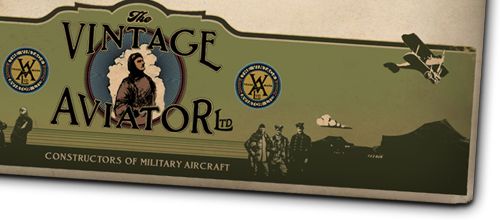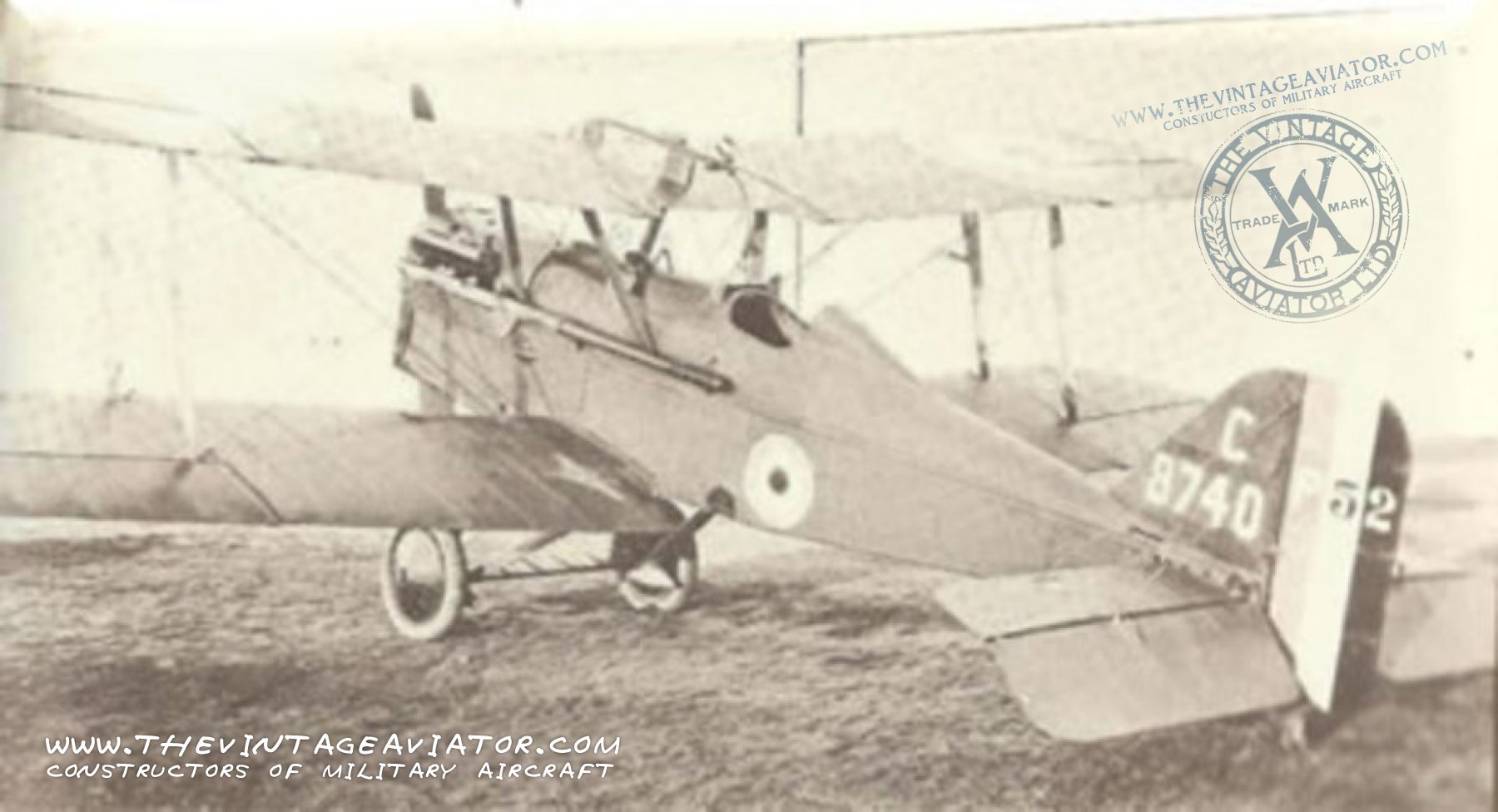You are here
SE.5a History
“Previous aircraft developed by Britains Royal Aircraft Factory emphasized stability in design although often to the detriment of the aircrafts combat ability. The 1916 design of Henry Folland and John Kenworthy of the SE.5 (Scout Experimental) featured improved manoueverability while still maintaining stability.”
Performance
The SE.5 required better performance and fire power than the under-powered and singulary armed Allied Sopwith Pup and French Nieuport. The aircraft needed to be relatively easy to fly considering the age and often inadequate experience of new pilots. A stable aircraft required a less hands on approach to flying, offered less volitile stall and spin characteristics, and provided a steadier gun platform, enabling pilots to open fire from a greater range than other less stable types.
The SE.5 was not designed to have the extreme manouverability skilled pilots were able to extort from the rotary powered Sopwith Camel, but neither did the SE.5 suffer the unnerving reputation of having lost almost as many pilots in handling as the Camel lost in active duty. Lt. Curt Kinny, flying Camels with the No.3 R.A.F squadron remembers more than one trainee pilot requesting a transfer to an SE.5 equipped squadron and recalls a conversation with fellow American Tom Herbert, flying SE.5s, with 56 Squadron. “I wouldn’t fly that damned pilot-killer camel” he said flatly “the SE.5 has power and speed and its so stable you can fly it hands off. I know the Camel is the most manouverable plane in the air, but I’ll take the SE.5”.
The SE.5's March 1917 introduction to active duty was fraught with technical problems surrounding the geared 150 h/p Hispano Suiza and Wolsely 200h/p engine. Limited numbers of this model SE.5 featuring the troublesome geared engine were produced. Airframe manufacture esculated ahead of engine production until Hispano Suiza, Wolsely and later Wright-Martin produced the direct drive 160hp/ 200hp/220hp Hispano Suiza; the 200h/p Wolsely Viper (A high compression version of the Hispano Suiza) and the ‘Model E’ respectively.
Modifications and Armament
Due to the difficulty of supply of the French built Hispano Suiza, insufficient numbers were immediately available at which time the English-built Wolseley Viper 200hp direct drive, water-cooled, V-8 engine became the standard fitting for this aircraft. Similtaneously the external appearance received some slight modifications from the original design. A headfaring behind the cockpit was added and Wing span was shortened to increase manouverability. Radiator shutters were then added and longer L-shaped exhaust pipes changed the outward appearance of what became designated the SE.5a.
The fuselage was a wire braced box-girder and the wings with wooden spars and ribs were braced internally. The fuselage was slightly narrower than other contemporary designs allowing the pilot a reasonably good all round view.The sides of the nose portion were of plywood and the fuel tank, mounted on the upper longerons was shaped to form the top of the fuselage. The tailplane was adjustable in flight, with the elevator control lines run internally. The landing wheels were supported on steel Vee-struts with rubber shock absorbers.
Armourment consisted of a 0.303in (7.7mm) forward firing Vickers machine gun holding 94 rounds, mounted on the port side of the fuselage in front of the cockpit and synchronized with Constantinesco interrupter gear to fire between the propeller blades. Also fitted was a 0.303in (7.7mm) Lewis Gun, providing 97 rounds, located on the top centre section of the upper wing with it’s fire converging with the Vickers at a range of 50 yards. Employed with previous success on the Nieuport 17, the Lewis Gun was carried on a curved ‘Foster Mount’, allowing the gun to be slid rearward and fired until almost vertical, the mount also facilitated re-loading. Provision was made beneath the fuselage for the carriage of four 25-lb (11.3kg) Cooper bombs.
As the Albatross D.III outclassed its contemporaries following its 1916 introduction, so did the SE.5a outclass the DIII, months later when it arrived in appreciable numbers at the Western Front. Much was made of the SE.5a’s speed, performance, stability, and strength. With a top speed of 138mph the SE.5a outperformed the Albatross at 109mph. Able to maintain 123mph at 15,000ft the SE.5a was reverred by pilots for its continued performance at altitude and its structural soundness at speeds of up to 225mph in a dive. Unfortunately the Albatross DIII and subsequent Dv designs displayed the disconcerting tendancy to lose the lower wing in a steep or prolonged dive. With parachute silk in short supply and extraction difficult from wire braced aircraft, allied pilots were able to make violent evasive moves in the SE.5 with confidence. 1050ft/min gave the SE.5 a better rate of climb performance than the Albatross’s 886 ft/min. The SE.5a remained competitive against all enemy designs for the duration of WWI, including the powerful Fokker D.VII , arriving in limited numbers in late 1918, producing quite a gain in the rate of climb and superlative performance at altitude.
The strength of the aircraft was often the subject of many a recorded damage report. Relayed by Royal Flying Corps, Lt. G. C Maxwell, his SE.5 crashed to the ground at 140mph, out of control after being hit by anti-aircraft fire. The aeroplane skidded a hundred yards; abandoned its engine and only then fell to bits as Maxwell climbed out unhurt. Another pilot reported flying through the side of a house and emerging unscathed. In the balance of stability VS manouverability the SE.5 was not as manouverable as the German Albatross or the Fokker Dr.I Triplane that followed. The D.III’s 2 synchronised Spandau machine guns fitted into the sleek, shark like nose of the aircraft were considered superior in firepower and reliability to the Vickers and Lewis guns of the SE.5.
SE.5 tactics advocated the use of speed in and out of dives. The SE.5a was not a renowned dog-fighter like the Sopwith Camel whose pilots manipulated the gyroscopic forces of the rotary engine and the instability of the aircraft to its best advantage. Mannock, McCudden, Bishop and Albert Ball, The Flying ‘Aces’ of WWI, achieved many of their victories flying the SE.5. James McCudden, an Irishman who had joined the RFC before the war as a mechanic was famous for tinkering with his SE.5 in an effort to constantly improve it. He installed high compression pistons following a workbench trial to produce more revolutions per minute, consequently adding an additional 9 mph to the aircrafts top speed.
In continously tuning and assessing his aeroplane, McCudden increased the service ceiling from the standard 17,000ft to 20,000ft. The Rumplers and LVG’s crossing British lines at an assumedly safe height of 17,000 feet were well met by Mc Cudden in his SE.5a. Tributes to McCudden suggest he produced another 3mph by fitting a spinner from an LVG he had shot down.
Service and Production
In service the SE.5a was often modified to suit the wishes of individual pilots. Some pilots reduced dihedral to increase manouverability or removed the headfaring to increase rearward visibility.As the Allies were enjoying greater success producing aircraft, the Germans as a result of the Allied offensive to curtail aeroplane manufacture suffered diminishing success. The exceptional German Fokker D.VII was unavailable in sufficient numbers to change what had been a pendulum swing of Air Superiority, throughout WWI, back into Allied hands for the last time. Production of SE.5s and Sopwith Camels continued until the 1918 Armistice at which time a production order with Curtiss in the U.S of 1000 SE.5s featuring the Wright Martin Model E was cancelled. SE.5’s remained on home guard duty and some even served as Skywriters during the twenties.
General characteristics
Crew: One
Length: 20 ft 11 in (6.38 m)
Wingspan: 26 ft 7 in (8.11 m)
Height: 9 ft 6 in (2.89 m)
Wing area: 444 ft² (22.67 m²)
Empty weight: 1,410 lb (639 kg)
Loaded weight: 1,935 lb (880 kg)
Max takeoff weight: 1,988 lb (902 kg)
Powerplant: 1× Wolseley Viper V8 engine, 200 hp (150 kW)
Performance
Maximum speed: 138 mph (222 km/h)
Range: 300 miles (483 km)
Service ceiling: 17,000 ft (5,185 m)
Armament
1x 0.303 in forward-firing Vickers machine gun with Constantinesco interrupter gear
1x .303 in Lewis gun on Foster mount on upper wing



